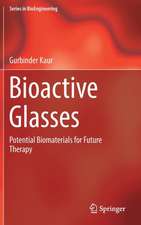Organic Additives and Ceramic Processing, Second Edition: With Applications in Powder Metallurgy, Ink, and Paint
Autor Daniel J. Shanefielden Limba Engleză Hardback – 31 aug 1996
Preț: 1220.71 lei
Preț vechi: 1488.67 lei
-18% Nou
Puncte Express: 1831
Preț estimativ în valută:
233.58€ • 243.88$ • 193.32£
233.58€ • 243.88$ • 193.32£
Carte tipărită la comandă
Livrare economică 04-18 aprilie
Preluare comenzi: 021 569.72.76
Specificații
ISBN-13: 9780792397656
ISBN-10: 0792397657
Pagini: 316
Ilustrații: XIV, 316 p.
Dimensiuni: 155 x 235 x 24 mm
Greutate: 0.69 kg
Ediția:2nd ed. 1996
Editura: Springer Us
Colecția Springer
Locul publicării:New York, NY, United States
ISBN-10: 0792397657
Pagini: 316
Ilustrații: XIV, 316 p.
Dimensiuni: 155 x 235 x 24 mm
Greutate: 0.69 kg
Ediția:2nd ed. 1996
Editura: Springer Us
Colecția Springer
Locul publicării:New York, NY, United States
Public țintă
ResearchCuprins
1. Introduction.- 1.1 Historical Overview.- 1.2 Typical Organic Additives.- 2. Chemical and Physical Bonding.- 2.1 Ordinary Bond Types.- 2.2 Lewis Acids And Bases.- 2.3 Hydrogen Bonds.- 2.4 Polarity.- 2.5 Radicals.- 2.6 Typical Structures.- 3. Organic Chemistry Fundamentals.- 3.1 The Naming System.- 3.2 Reactions.- 3.3 Synthetic Polymers.- 3.4 Natural Carbohydrates.- 3.5 Hydrogen Bonds and Life.- 4. Ceramic Processing Fundamentals.- 4.1 The Process Steps From Powder To Ceramic.- 4.2 Agglomerates.- 4.3 Optimum Surface Area.- 5. Particle Characteristics.- 5.1 The Packing Of Powders.- 5.2 Surface Area Calculations.- 6. Colloid Science, As Applied To Ceramics.- 6.1 Adsorption.- 6.2 Charged Particles In Suspension.- 6.3 Stabilized Suspensions.- 6.4 Viscosity.- 6.5 Wetting.- 7. Solvents.- 7.1 Predicting Solubility.- 7.2 Hydrogen Bonding Effects.- 7.3 Safety.- 7.4 Cost.- 7.5 Chemical Attack on the Powder.- 8. Dispersants And Other Surfactants.- 8.1 Tests For Effectiveness.- 8.2 Commonly Used Detergents.- 8.3 Inorganic Surfactants.- 8.4 Organic Deflocculants For Ceramics.- 9. Binders.- 9.1 Burnout.- 9.2 Adhesion.- 9.3 Green Strength.- 9.4 Other Additives.- 10. Processing Examples.- 10.1 Dry Pressing.- 10.2 Injection Molding.- 10.3 Extrusion.- 10.4 Tape Casting.- 10.5 Slip Casting.- Appendix I. Glossary of Ceramics Words.- Appendix II. Words Used in Colloid Science.- Appendix III. Information Sources.



















